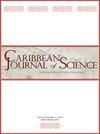The Importance of Urban Green Spaces for Pollinating Insects: The Case of the Metropolitan Area of Port-au-Prince, Haiti
IF 0.5
4区 生物学
Q4 BIODIVERSITY CONSERVATION
引用次数: 3
Abstract
Abstract The relative contribution of urban agriculture vs. urban forest remnants to the preservation of insect diversity in large cities, particularly in developing countries in the tropics, remains poorly documented. We assessed the distribution of pollinating insect orders in the densely-populated capital city of Port-au-Prince, Haiti, one of the poorest countries in the world. From early January to late April 2018, a survey was conducted in 16 urban green sites, consisting of eight unexploited, private secondary forest remnants (Fo) and eight agroforestry plantations (Ag) embedded within the urban landscape. At each site, we relied on coloured pan traps as an efficient way to sample pollinating insects during three different 24 hour sampling sessions. Overall, we collected a total of 2,747 pollinating insects, belonging to six different orders (Coleoptera, Diptera, Hemiptera, Hymenoptera, Lepidoptera, and Thysanoptera). Site area, site elevation, and percentage of built area within a 500 m radius had no significant influence on the total number of insects collected at each site. Insect order richness was significantly higher at Ag sites compared to Fo ones. Although it was not possible to identify all collected insects at the family or species level, we collected two Lepidopteran species of patrimonial interest, the Hispaniolan-endemic Zetides Swallowtail, Battus zetides, and the Jaeger's anetia, Anetia jaegeri, in our pan traps during the course of the survey. We discuss our results in relation to the value of urban green spaces for the conservation of pollinating insects and particular characteristics of the metropolitan area of Port-au-Prince.城市绿地对传粉昆虫的重要性:以海地太子港大都市区为例
城市农业与城市森林遗迹对大城市昆虫多样性保护的相对贡献,特别是在热带发展中国家,文献记录很少。我们在人口稠密的海地首都太子港(世界上最贫穷的国家之一)评估了传粉昆虫的分布。2018年1月初至4月底,对16个城市绿地进行了调查,包括8个未开发的私人次生林遗迹(Fo)和8个嵌入城市景观的农林业人工林(Ag)。在每个地点,我们在三个不同的24小时采样期间,依靠彩色平底陷阱作为有效的方法来取样传粉昆虫。共采集到传粉昆虫2747只,分属鞘翅目、双翅目、半翅目、膜翅目、鳞翅目和囊翅目6目。站点面积、站点海拔和500 m半径内的建成区百分比对每个站点的昆虫总数无显著影响。Ag样地昆虫目丰富度显著高于Fo样地。虽然不可能在科或种水平上对收集到的所有昆虫进行鉴定,但在调查过程中,我们用平底陷阱收集了两种具有遗传意义的鳞翅目昆虫,即伊斯帕尼奥岛特有的Zetides Swallowtail, batus Zetides和Jaeger's anetia jaegeri。我们讨论了与城市绿地对传粉昆虫保护的价值和太子港大都市区的特点有关的结果。
本文章由计算机程序翻译,如有差异,请以英文原文为准。
求助全文
约1分钟内获得全文
求助全文
来源期刊

Caribbean Journal of Science
综合性期刊-生物多样性保护
CiteScore
1.00
自引率
25.00%
发文量
21
审稿时长
>12 weeks
期刊介绍:
The Caribbean Journal of Science publishes articles, research notes, and book reviews pertinent to natural science of the Caribbean region. The emphasis is on botany, zoology, ecology, conservation biology and management, geology, archaeology, and paleontology. The mission as a nonprofit scholarly journal is to publish quality, peer-reviewed papers and to make them widely available.
 求助内容:
求助内容: 应助结果提醒方式:
应助结果提醒方式:


